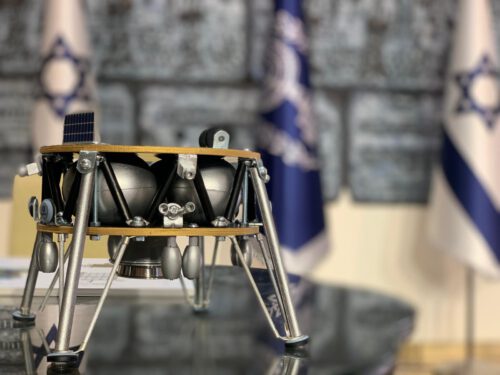Antavi, currently head of the systems engineering program at Afka College, emphasizes the importance of systemic planning in complex projects. He also told about the meeting that made Berashit the prototype of the moon landings in NASA's tenders
The lunar lander Peregrine is expected to enter the atmosphere and burn up in it the American private lunar lander Peregrine of the Astrobotics company. As we will see later, this is not the first lunar lander or private spacecraft that fails to reach its destination.
Dr. Ido Antavi, head of the master's degree program in systems engineering at Afka, the academic college of engineering in Tel Aviv and former CEO of the SPACEIL association emphasizes the importance of systemic planning in such projects: "There are engineers today who are systems engineers. They learn how to manage complex technological projects." Antavi explains that the success of projects like "Bereshit" depends not only on technological innovation, but also on the ability to manage complex projects in an efficient and coordinated manner."
A series of failures in landing on the moon
Failures Peregrine encountered a malfunction after its launch, which led to a fuel leak. The spacecraft was successfully launched aboard a United Launch Alliance Vulcan Centaur rocket from the Cape Canaveral Space Center on January 8, 2024, but the subsequent fuel leak derailed it. After it became clear that Peregrine would not reach the moon, it was decided to gather as much information as possible to correct what was needed in the following missions.
Peregrine is not the first private lunar lander to reach its destination. In recent years, there has been a series of failures of private and governmental entities.
The Israeli "Beresheet" spacecraft failed to land on the moon on April 11, 2019 after a failure in its gyroscopes caused the main engine to shut down and crash on the moon. The Indian "Chandrayaan-2" was launched on July 2, 22. The rover and lander were supposed to land in the south pole region of the moon on September 2019, 6, but it too crashed due to a software glitch.
In the Japanese "Hakuto-R Mission 1" spacecraft: Hakuto-R Mission 1 was a private Japanese space mission to land on the moon built and operated by ispace. It was launched in December 1 and is scheduled to land in April 2022. The spacecraft reached a distance of approximately 2023 km, the farthest distance a privately funded spacecraft has ever reached. But communication with the spaceship was lost and it too crashed.
Antavi tells about the decisive meeting with the head of NASA, which led to the transformation of Berashit into a prototype for NASA's future spaceships.

Genesis' legs became the standard
"The new head of NASA at the time, Jim Bridenstine, arrived in Israel as part of his first visit in 2018. Me and members of the Spice-IL team met him that day," says Antavi. "During the meeting we presented the spacecraft and discussed cooperation. "We sat with him for an hour or so and showed him the spacecraft." Antavi describes how the head of NASA's impression of "Bereshit" and the interest shown in the project led to an important change in NASA's approach towards private projects in space."
Antavi adds that "Bereshit was a prototype for the future lunar landers and was the basis for the tender that they went on NASA's lunar missions." He notes the impact of the "Genesis" project on NASA's future plans, and the focus on cooperation with private companies and reducing costs: "In 2019, NASA launched a tender for three launches to the moon as part of the preparations for the Artemis program. The budget offered by NASA for these launches was quite similar to that of Genesis - about 100 million dollars. Astrobotics is the first among them whose budget started at 80 million dollars and eventually qualified for 100 million. Apart from quite a few specific technologies of Bereshit that were adopted by the three tender winners, the concept of building a light spaceship with a little redundancy was also adopted, because all these things increase the weight and therefore the price of the spacecraft.

When Elon Musk's Starship spacecraft crashed, many considered it a failure, but Entavi's opinion is different: "The Starship launches are a huge success. Those who think that such a thing can be done for the first time do not understand that such a launch costs 10 times the SpaceX approach of trial and error is an approach that has proven itself. It doesn't exist in the culture of the defense industry or the space industry. Generally, you see, this is the only way to shorten schedules and also to reduce costs, provided that there are no people there. When sending people you need to be XNUMX percent convinced. When the first starship crashed, the second one was already under construction, because Elon Musk knew it would crash, he just didn't know when and for what reason. Both Starship launches are amazing successes and I have no doubt that the next Starship launch will involve the Starship taking off, releasing a payload and landing. But it will take more interaction and more interaction.”
According to him, of course all these trials and tribulations should be carried out until a safe spaceship is reached that humans can be put into.
Antavi closes the interview with hope and optimism: "In five years such spaceships will be flying to the moon as usual." He expresses confidence in the future of private space programs and in changing the existing government model.
More of the topic in Hayadan:
- The Google Lunar X Prize contest will end without a winner
- The Peregrine lunar lander will no longer reach its destination due to a malfunction
- Dr. Ido Entavi is retiring from the position of CEO of SpaceIL
- The Peregrine lunar lander was launched - the first private lander and also the first American landing since Apollo
- The moon will have to wait another year

One response
Why are there so many spelling errors and lack of punctuation and periods? It's hard to read the article like that.